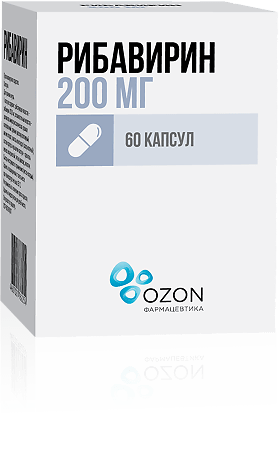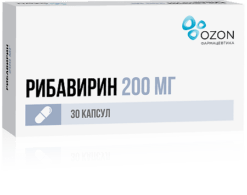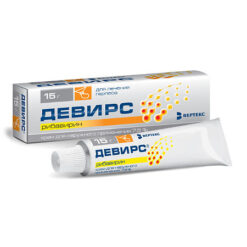No products in the cart.
Description
Ribavirin is a synthetic nucleoside analogue with a pronounced antiviral effect. It has a wide spectrum of activity against various DNA and RNA viruses.
Pharmacodynamics
Ribavirin easily penetrates into virus-infected cells and is quickly phosphorylated by intracellular adenosine kinase into ribavirin mono-, di- and triphosphate. These metabolites, especially ribavirin triphosphate, have pronounced antiviral activity.
The mechanism of ribavirin action is not well elucidated. However, it is known that ribavirin inhibits inosine monophosphate dehydrogenase (IMF), this effect leads to a marked decrease in intracellular guanosine triphosphate (GTP) levels, which, in turn, is accompanied by suppression of synthesis of viral RNA and virus-specific proteins. Ribavirin inhibits replication of new virions, which ensures reduction of viral load. Ribavirin selectively inhibits viral RNA synthesis without suppressing RNA synthesis in normally functioning cells.
Ribavirin is effective against many DNA and RNA viruses. The DNA viruses most sensitive to rnbavirin are: Simplex herpes virus, poks-virus, virus of Marek’s disease. The viruses insensitive to rnbavirin DNA are: Varicella Zoster, pseudorabies, cow smallpox. The most ribavirin-sensitive RNA viruses are: influenza A, B, paramyxovirus (parainfluenza, epidemic parotite, Nucasl’s illness), reoviruses, RNA tumoral viruses. RNA RNA viruses insensitive to ribavirin are: enteroviruses, rhinovirus, Semlicy Forest.
Ribavirin has activity against hepatitis C virus (HCV). The mechanism of action of ribavirin against HCV is not fully clarified. It is assumed that ribavirin triphosphate accumulates with phosphorylation and competitively inhibits formation of guanosine triphosphate, thereby reducing the synthesis of viral RNA. It is also believed that the mechanism of synergistic action of ribavirin and interferon alpha against HCV is due to increased phosphorylation of ribavirin by interferon.
Pharmacokinetics
Absorption: When administered orally, ribavirin is rapidly absorbed in the gastrointestinal tract. Its bioavailability is more than 45%.
Distribution: Ribavirin is distributed in plasma, respiratory tract mucosal secretion and erythrocytes. A large amount of ribavirin triphosphate accumulates in erythrocytes, reaching a plateau by day 4 and persisting for several weeks after administration. The half-life is 3.7 h. The volume of distribution (Vd) is 647 -802 l. When administered during a course of treatment, ribavirin accumulates in the plasma in large amounts. The ratio of bioavailability indices (AUC – area under the curve “concentration/time”) in repeated and single administration is 6. Significant concentration of ribavirin (over 67%) can be detected in cerebrospinal fluid after long-term use. It is insignificantly bound to plasma proteins.
The time of reaching of maximum concentration in plasma is from 1 to 1.5 hours.
The time of reaching of therapeutic concentration in plasma depends on the value of minute blood volume.
The average value of maximum concentration (Cmax) in plasma: about 5 μmol per liter at the end of 1 week of administration at a dose of 200 mg every 8 hours and about 11 μmol per liter at the end of 1 week of administration at a dose of 400 mg every 8 hours.
Biotransformation: ribavirin is phosphorylated in liver cells into active metabolites as mono-, di- and triphosphate, which are then metabolized to 1,2,4 – triazolecarboxamide (amide hydrolysis to tricarboxylic acid and deribosylation to form a triazole carboxyl metabolite).
Excretion: Ribavirin is excreted slowly. Elimination half-life (T½) after a single dose of 200 mg is 1 to 2 hours from plasma and up to 40 days from erythrocytes. After discontinuation of a course of administration, T½ is about 300 hours. Ribavirin and its metabolites are mainly excreted with urine. Only about 10% is excreted with feces. About 7% of ribavirin is excreted unchanged in 24 hours and about 10% – in 48 hours.
Pharmacokinetics in special clinical conditions: While taking the preparation in patients with renal insufficiency AUC and Cmax of ribavirin are increased due to the decrease of true clearance. Pharmacokinetics of ribavirin does not change in patients with hepatic insufficiency (A, B and C degree). Ribavirin pharmacokinetics changes significantly after taking a single dose with fat containing food (AUC and Cmax increase by 70%).
Indications
Indications
Oral (in combination with interferon alfa-2b or peginterferon alfa-2b):
chronic hepatitis C (in patients not previously treated with interferon alfa-2b or peginterferon alfa-2b;
during exacerbation after a course of monotherapy with interferon alfa-2b or peginterferon alfa-2b;
in patients refractory to monotherapy with interferon alfa-2b or peginterferon alfa-2b).
Pharmacological effect
Pharmacological effect
Ribavirin is a synthetic analogue of nucleosides with a pronounced antiviral effect. It has a wide spectrum of activity against various DNA and RNA viruses.
Pharmacodynamics
Ribavirin easily penetrates virus-infected cells and is quickly phosphorylated by intracellular adenosine kinase into ribavirin mono-, di- and triphosphate. These metabolites, especially ribavirin triphosphate, have pronounced antiviral activity.
The mechanism of action of ribavirin is not well understood. However, it is known that ribavirin inhibits inosine monophosphate dehydrogenase (IMP), this effect leads to a marked decrease in the level of intracellular guanosine triphosphate (GTP), which, in turn, is accompanied by suppression of the synthesis of viral RNA and virus-specific proteins. Ribavirin inhibits the replication of new virions, which reduces the viral load. Ribavirin selectively inhibits viral RNA synthesis without suppressing RNA synthesis in normally functioning cells.
Ribavirin is effective against many DNA and RNA viruses. The most sensitive DNA viruses to rnbavirin are: Simplex herpes virus, poks-virus, virus of Marek’s illness. DNA viruses insensitive to rnbavirin are: Varicella Zoster, pseudorabies, cow smallpox. The most sensitive RNA viruses to ribavirin are: influenza A, B, paramyxovirus (parainfluenza, epidemic parotite, Nucasl’s illness), reoviruses, RNA tumoral viruses. RNA viruses insensitive to ribavirin are: enteroviruses, rhinovirus, Semlicy Forest.
Ribavirin has activity against the hepatitis C virus (HCV). The mechanism of action of ribavirin against HCV is not fully understood. It is assumed that ribavirin triphosphate, which accumulates during phosphorylation, competitively inhibits the formation of guanosine triphosphate, thereby reducing the synthesis of viral RNA. It is also believed that the mechanism of synergistic action of ribavirin and alpha interferon against HCV is due to increased phosphorylation of ribavirin by interferon.
Pharmacokinetics
Absorption: When administered orally, ribavirin is rapidly absorbed from the gastrointestinal tract. Moreover, its bioavailability is more than 45%.
Distribution: ribavirin is distributed in plasma, secretions of the respiratory tract mucosa and erythrocytes. Large amounts of ribavirin triphosphate accumulate in red blood cells, reaching a plateau by day 4 and persisting for several weeks after administration. The half-life of distribution is 3.7 hours. The volume of distribution (Vd) is 647 -802 l. When taken as a course, ribavirin accumulates in the plasma in large quantities. The ratio of bioavailability indicators (AUC – area under the concentration/time curve) for repeated and single doses is 6. A significant concentration of ribavirin (more than 67%) can be detected in the cerebrospinal fluid after long-term use. Slightly binds to plasma proteins.
The time to reach maximum plasma concentration is from 1 to 1.5 hours.
The time to reach therapeutic plasma concentrations depends on the minute volume of blood.
Average maximum concentration (Cmax) in plasma: about 5 µmol per liter at the end of 1 week of taking a dose of 200 mg every 8 hours and about 11 µmol per liter at the end of 1 week of taking 400 mg every 8 hours.
Biotransformation: ribavirin is phosphorylated in liver cells into active metabolites in the form of mono-, di- and triphosphate, which are then metabolized to 1,2,4-triazolecarboxamide (amide hydrolysis to tricarboxylic acid and deribosylation to form the triazole carboxyl metabolite).
Elimination: Ribavirin is excreted slowly from the body. The half-life (T½) after a single dose of 200 mg is 1 to 2 hours from plasma and up to 40 days from red blood cells. After stopping the course of treatment, T½ is about 300 hours. Ribavirin and its metabolites are mainly excreted from the body in the urine. Only about 10% is excreted in the feces. In unchanged form, about 7% of ribavirin is eliminated within 24 hours and about 10% within 48 hours.
Pharmacokinetics in special clinical conditions: When taking the drug in patients with renal failure, the AUC and Cmax of ribavirin increase, which is due to a decrease in true clearance. In patients with liver failure (grades A, B and C), the pharmacokinetics of ribavirin does not change. After taking a single dose with a meal containing fat, the pharmacokinetics of ribavirin changes significantly (AUC and Cmax increase by 70%).
Special instructions
Special instructions
The teratogenicity of the drug should be taken into account; men and women of reproductive age should use effective contraceptives during treatment and for 7 months after the end of therapy.
Laboratory tests (clinical blood test with calculation of leukocyte formula and platelet count, determination of electrolytes, creatinine content, liver function tests) must be carried out before starting therapy, at 2 and 4 weeks, and then regularly.
During treatment with ribavirin, the maximum decrease in hemoglobin levels in most cases is observed after 4-8 weeks from the start of treatment. If hemoglobin decreases below 110 mg/ml, the dose of ribavirin should be temporarily reduced by 400 mg per day; if hemoglobin decreases below 100 mg/ml, the dose should be reduced to 50% of the original. In most cases, recommended dose changes will restore hemoglobin levels. If hemoglobin decreases below 85 mg/ml, the drug should be discontinued.
In case of acute manifestation of hypersensitivity (urticaria, angioedema, bronchospasm, anaphylaxis), the use of the drug should be stopped immediately. Transient rashes do not serve as a reason to interrupt treatment.
During the treatment period, persons experiencing fatigue, drowsiness or disorientation should refrain from driving vehicles and engaging in potentially hazardous activities that require increased concentration and speed of psychomotor reactions.
Due to the possible deterioration of renal function in elderly patients, before using the drug, it is necessary to determine renal function, in particular creatinine clearance.
Active ingredient
Active ingredient
Ribavirin
Composition
Composition
Active ingredient: ribavirin 200 mg
Contraindications
Contraindications
Hypersensitivity, pregnancy, lactation period, chronic heart failure stage II6-III, myocardial infarction, renal failure (creatinine clearance – less than 50 ml/min), severe anemia, liver failure, decompensated liver cirrhosis, autoimmune diseases (including autoimmune hepatitis), untreatable thyroid diseases, severe depression with suicidal intentions, childhood and adolescence (up to 18 years).
With caution: women of reproductive age (pregnancy is undesirable), decompensated diabetes mellitus (with attacks of ketoacidosis); chronic obstructive pulmonary disease, pulmonary embolism, chronic heart failure, thyroid disease (including thyrotoxicosis), blood clotting disorders, thrombophlebitis, myelodepression, hemoglobinopathy (including thalassemia, sickle cell anemia), depression, suicidal tendencies (including history), old age.
Side Effects
Side Effects
From the nervous system: headache, dizziness, general weakness, malaise, insomnia, asthenia, depression, irritability, anxiety, emotional lability, nervousness, agitation, aggressive behavior, confusion; rarely – suicidal tendencies, increased smooth muscle tone, tremor, paresthesia, hyperesthesia, hypoesthesia, fainting.
From the cardiovascular system: decrease or increase in blood pressure, bradycardia or tachycardia, palpitations, cardiac arrest.
From the hematopoietic organs: hemolytic anemia, leukopenia, neutropenia, granulocytopenia, thrombocytopenia; extremely rarely – aplastic anemia.
From the respiratory system: dyspnea, cough, pharyngitis, shortness of breath, bronchitis, otitis media, sinusitis, rhinitis.
From the digestive system: dry mouth, loss of appetite, nausea, vomiting, diarrhea, abdominal pain, constipation, taste disturbance, pancreatitis, flatulence, stomatitis, glossitis, bleeding from the gums, hyperbilirubinemia.
From the senses: damage to the lacrimal gland, conjunctivitis, visual impairment, hearing impairment/loss, tinnitus.
From the musculoskeletal system: arthralgia, myalgia.
From the genitourinary system: hot flashes, decreased libido, dysmenorrhea, amenorrhea, menorrhagia, prostatitis.
Allergic reactions: skin rash, erythema, urticaria, hyperthermia, angioedema, bronchospasm, anaphylaxis, photosensitivity, erythema multiforme, Stevens-Johnson syndrome, toxic epidermal necrolysis.
Other: hair loss, conjunctivitis, alopecia, hair disorder, dry skin, hypothyroidism, chest pain, thirst, fungal infection, viral infection, influenza-like syndrome, sweating, lymphadenopathy.
Interaction
Interaction
Medicines containing magnesium and aluminum compounds, simethicone, reduce the bioavailability of the drug (AUC decreases by 14%, has no clinical significance).
When used together with interferon alfa-2b or peginterferon alfa-2b, there is a synergistic effect.
The administration of ribavirin during treatment with zidovudine and/or stavudine is accompanied by a decrease in their phosphorylation, which can lead to HIV viremia and require a change in the treatment regimen.
Increases the concentration of phosphorylated metabolites of purine nucleosides (including didanosine, abacavir) and the associated risk of developing lactic acidosis.
Does not affect the enzymatic activity of the liver involving cytochrome P450.
Concomitant consumption of a high-fat meal increases the bioavailability of ribavirin (AUC and Cmax increase by 70%).
Overdose
Overdose
The severity of side effects may increase.
Treatment: drug withdrawal, symptomatic therapy.
Storage conditions
Storage conditions
In a dry place, protected from light, at a temperature not exceeding 25 °C
Shelf life
Shelf life
3 years
Manufacturer
Manufacturer
Ozon, Russia
Additional information
| Shelf life | 3 years |
|---|---|
| Conditions of storage | In a dry, light-protected place at a temperature not exceeding 25 °C |
| Manufacturer | Ozon, Russia |
| Medication form | capsules |
| Brand | Ozon |
Other forms…
Related products
Buy Ribavirin, 200 mg capsules 60 pcs with delivery to USA, UK, Europe and over 120 other countries.












